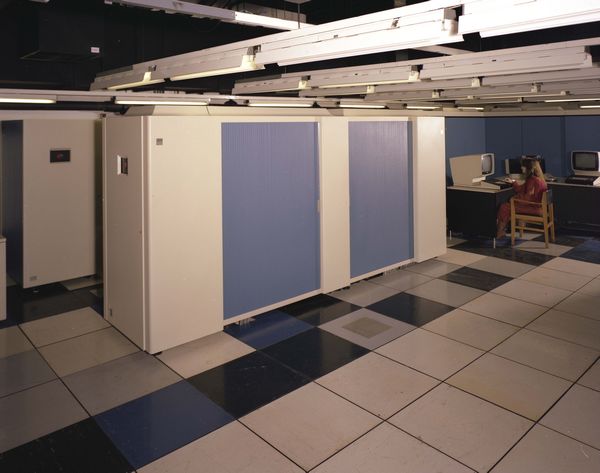

The IBM 3081 was announced by IBM on November 12, 1980 and withdrawn August 4, 1987.
The IBM 3081D was the smallest of the three 3081 systems which itself was the smallest of the 3081, 3083, 3084 range.
This Series introduced the System/370 Extended Architecture which added functionality to the 370 architecture while allowing continued execution of existing programs. It, therefore, was an easy replacement for the 3032.

The IBM 3081 was the first IBM mainframe implemented in LSI technology and the cycle time was 26 nanoseconds. Full details of the design are given in IBM 3081 Processor Unit: Design Considerations and Design Process.
The IBM 3081D CPU was 20 times faster than the 3033 (the top end of the 3031, 3032, 3033 range). The IBM 3081 was a modern system providing support for:
The 3081D was installed in July 1982. It was at the low-end of the possible machines with 16 Mbytes of memory and 16 channels. There was an immediate substantial reduction in operating costs both on the electricity bill and the maintenance charges.
The 3081D turned out to be 2.5 to 3 times the 360/195 in performance which was a modest increase considering the difference in the ages of the machines which just demonstrates how fast the 360/195 was for its age. The big immediate advantage was the size of programme that could be run. As well as having 8 times as much memory, the virtual memory allowed even larger programs to run without all the overhead of breaking the program into overlays.
The 360/195s had been running MVT and the 3081D was brought into service running MVT but with the plan to migrate to MVS as soon as possible. The VM hypervisor allowed the MVS system to be developed at the same time as the 3081 was running MVT.
The IBM 3032 had started the phase out of the ELECTRIC interactive editing system replacing it with CMS. This continued and ELECTRIC was closed down in 1984.
The 3081 replaced the 3032 as the front-end system in September 1983. the Atlas 10 arrived in April and was handed over in August thus completing the move from the 360/195s to the new combined 3081-Atlas 10 system.
It took until July 1984 to move the workload from MVT to MVS.
In 1984, the 3081D was replaced by a new 32-Mbyte system. IBM tended to change its currency conversions to local currency at infrequent intervals. With the volatility of the exchange rate at that time, it meant that the price of IBM equipment in Germany was significantly higher than in the UK. This resulted in the price of second-hand equipment in Germany also being much higher. It was possible to sell the second-hand 3081 to a German company and purchase a new 3081 with twice the memory at no cost. The major problem was persuading SERC that there was nothing underhand going on!
The changeover was made successfully and the first 3081 was air-freighted to Germany. Unfortunately, the plane it was due to travel on crashed en route. The German company was insured and so they were not worried and felt they might even get a new 3081 as a result. However, it later turned out that just before take off, the plane was over its weight limit and the 3081 was unshipped to await the next plane. It eventually arrived in Germany.